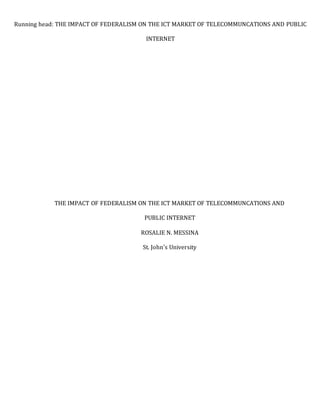
CA pt 1 reflection
- 1. THE IMPACT OF FEDERALISM ON THE ICT MARKET OF TELECOMMUNCATIONS AND PUBLIC INTERNET ROSALIE N. MESSINA St. John's University Running head: THE IMPACT OF FEDERALISM ON THE ICT MARKET OF TELECOMMUNCATIONS AND PUBLIC INTERNET
- 2. 2 What I found most striking about the Part 1 of Cowhey and Aaronson’s piece was their description of the American political institution. Specifically, the impact of federalism on ICT markets, and the impact that past presidential administrations have had in shaping the marketplace of telecommunications and publicly available Internet. The authors set forth the idea that there have been two past eras in which ICT markets have transgressed. The first began post-World War II, and the second began in 1984 after the breakup of the mobile provider AT&T, and lasted until the new millennium in 2000. Prior to the 1960s, telecommunications and broadcast required separate networks. Major IT users were governments and large enterprise buyers. However, the 1960s challenged this unilateral model, which gave little access to the public. The result was modularity, a conceptual breakthrough that addressed the argument between those who intended to make connecting equipment to networks possible, versus those who wished to keep the network privatized, honing its integrity. A result was the expansion of the market of programmers who could write computer code independently of large computer companies. (Cowhey, 22) Public policy in the United States helped drive this market revolution, which lead to an opening of new networks, user demands and responses to pre-existing policies. In this way, the US differed from most other large nations at the time, whose networks were dominated by vertically integrated, government-owned firms. The theory during the first era of the technology and market revolution of the United States was that policy evolution could move quickly if economic interests and political institutions are aligned. (Cowhey, 30) This meant that the government
- 3. 3 sought to distinguish which network services should be available for public use, so that the benefits of ICTs could be consumed by the masses, not remain monopolized by a few large enterprises. This would foster the creation of value-added technologies and competitively provided services that wouldn’t undermine the service of a general public network. While initially successful, this lead to the second era, which was characterized by slow economic growth and high inflation in the 1970s. As a result, there was now a deregulation of public utilities. To combat this, price caps were designed to foster pro-competitive interconnections that existed between new entrants into the market, and also kept prices in check. This strategy was first implemented during the Clinton administration, where telecommunications policy was instituted to show a clear support of pro- competition and pro-innovation in the technological world. The effect of this policy was a push for technological and economic efficiency. In fact, George W. Bush worried about the potential embarrassment of America’s lagging position on the deployment of broadband, if such reforms to promote technological and service innovation for ICT were not instituted. However, three policies emerged that proved politically successful: 1) price adjustments of local services, 2) regulatory forms to promote ICT innovation, and 3) a new sensitivity to employment efforts that can be created by publicly available networks. In all, Cowhey and Aaronson purport that market governance began with the development of two ICT markets: a monopolized telecommunications market, and the development of the computer and software industry. Ultimately, US political
- 4. 4 policies on public network availability shaped the success of ICT development and its market economy.